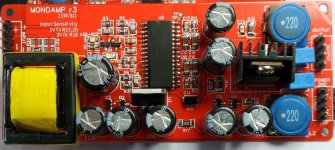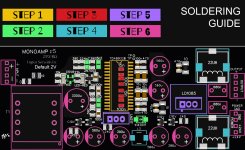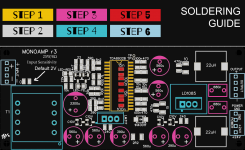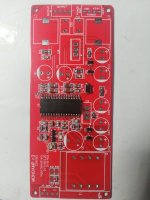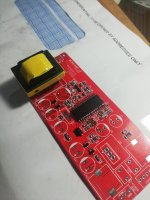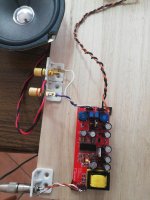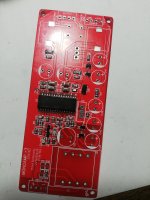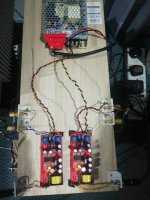Orders now are open on TDA8932 mono amp kits - feel free to PM me.
Preferred payment method is via Transfer Money Online | Send Money Abroad with TransferWise which typically adds a 2% fee. Our receiving currency is either CNY, USD or Euro in order of preference. PayPal may also be used (in USD) but subject to an additional fee.
Kit for a pair of mono amps with transformer input : 280RMB ($39.50) Built and tested amps, 520RMB ($73) per pair.
Cost-up options to the base level kit as follows. Note the base level kit includes all parts needed for a working amp board, these options substitute various components for those interested in gilding the lily :
Shunt regs (pre-built, pair) : +100RMB
Flat-wire 22uH output inductors (set of 4) : +48RMB (Coilcraft look-alikes and spec-alikes, we cannot be sure they're original Coilcraft).
EE25 permalloy-cored transformer : +100RMB/pair
We are at present only selling amp kits in multiples of two. Kits contain all the parts you need to build 2 off mono amps, excluding power supply. Most of the parts are SMD, the smallest are 0805. If you've only done conventional (through-hole) soldering before this kit could be a handy introduction into surface mount tech. The trickiest part to solder is the TDA8932 itself, it has 32pins on a 1.27mm pitch.
Shipping is in addition and depends on your location and speed of service.
The amp is rated at 25W into an 8ohm load and is BTL - the power rating is a fairly conservative one on music but its not been designed to deliver 25W continuously. The amp IC contains thermal overload protection should its temperature rise too high. The suggested power supply (extra) is a single 24V @3A switching brick for each channel. Thus a stereo setup should have a 24V/6A supply.
Gain is 17dB by default (2VRMS sensitivity), with two resistor changes it can become 23dB (1VRMS sensitivity). If you fit the Aliexpress trafo these numbers become 21dB and 27dB. Since signal transformers are very sensitive to DC you should always use a coupling cap between your source and this amp. 47uF is the minimum recommended value with the stock trafo at 17dB gain, 220uF at 23dB. 4.7uF is fine for the Aliexpress trafo. A too-low coupling cap will result in bass boost due to the resonance between the cap and the trafo's primary inductance.
The original development thread with schematic and technical background is here : Transformer input TDA8932 mono amp
TDA8932 datasheet is attached for those wishing to look in more detail.
<Update Aug 2022>
The PCB is up to rev5 now and accommodates a few options:
a) You can fit a low-noise shunt regulator board in place of U3 (a three-terminal regulator, either LM317 or LM350). To use the shunt you'll need to solder a 0R resistor for R17 and remove R15. C38 isn't fitted when the shunt is used.
b) The transformer footprint accepts a 20k:600R centre-tapped EE25 transformer from Taobao/Aliexpress in place of our custom trafo. https://www.aliexpress.com/item/2251832717562057.html. The reason for choosing this trafo over the stock one is so you can couple to it with a 10X lower value cap due to its much higher primary inductance. It also increases the gain of the amp by about 4dB.
c) Coilcraft flat-wire output inductors can be fitted, part number SER1390-223

Old (prior to Aug '22) shunt orientation (earlier PCB revision but orientation the same) :

Current shunt orientation - note the latest shunts say 'Low-noise Shunt' on the silkscreen.

Preferred payment method is via Transfer Money Online | Send Money Abroad with TransferWise which typically adds a 2% fee. Our receiving currency is either CNY, USD or Euro in order of preference. PayPal may also be used (in USD) but subject to an additional fee.
Kit for a pair of mono amps with transformer input : 280RMB ($39.50) Built and tested amps, 520RMB ($73) per pair.
Cost-up options to the base level kit as follows. Note the base level kit includes all parts needed for a working amp board, these options substitute various components for those interested in gilding the lily :
Shunt regs (pre-built, pair) : +100RMB
Flat-wire 22uH output inductors (set of 4) : +48RMB (Coilcraft look-alikes and spec-alikes, we cannot be sure they're original Coilcraft).
EE25 permalloy-cored transformer : +100RMB/pair
We are at present only selling amp kits in multiples of two. Kits contain all the parts you need to build 2 off mono amps, excluding power supply. Most of the parts are SMD, the smallest are 0805. If you've only done conventional (through-hole) soldering before this kit could be a handy introduction into surface mount tech. The trickiest part to solder is the TDA8932 itself, it has 32pins on a 1.27mm pitch.
Shipping is in addition and depends on your location and speed of service.
The amp is rated at 25W into an 8ohm load and is BTL - the power rating is a fairly conservative one on music but its not been designed to deliver 25W continuously. The amp IC contains thermal overload protection should its temperature rise too high. The suggested power supply (extra) is a single 24V @3A switching brick for each channel. Thus a stereo setup should have a 24V/6A supply.
Gain is 17dB by default (2VRMS sensitivity), with two resistor changes it can become 23dB (1VRMS sensitivity). If you fit the Aliexpress trafo these numbers become 21dB and 27dB. Since signal transformers are very sensitive to DC you should always use a coupling cap between your source and this amp. 47uF is the minimum recommended value with the stock trafo at 17dB gain, 220uF at 23dB. 4.7uF is fine for the Aliexpress trafo. A too-low coupling cap will result in bass boost due to the resonance between the cap and the trafo's primary inductance.
The original development thread with schematic and technical background is here : Transformer input TDA8932 mono amp
TDA8932 datasheet is attached for those wishing to look in more detail.
<Update Aug 2022>
The PCB is up to rev5 now and accommodates a few options:
a) You can fit a low-noise shunt regulator board in place of U3 (a three-terminal regulator, either LM317 or LM350). To use the shunt you'll need to solder a 0R resistor for R17 and remove R15. C38 isn't fitted when the shunt is used.
b) The transformer footprint accepts a 20k:600R centre-tapped EE25 transformer from Taobao/Aliexpress in place of our custom trafo. https://www.aliexpress.com/item/2251832717562057.html. The reason for choosing this trafo over the stock one is so you can couple to it with a 10X lower value cap due to its much higher primary inductance. It also increases the gain of the amp by about 4dB.
c) Coilcraft flat-wire output inductors can be fitted, part number SER1390-223
Old (prior to Aug '22) shunt orientation (earlier PCB revision but orientation the same) :
Current shunt orientation - note the latest shunts say 'Low-noise Shunt' on the silkscreen.
Attachments
Last edited:
Driving these amps from PhiDAC hex will need a slight modification to the DAC as the output coupling capacitor value is below the minimum recommended for driving the transformer.
The mod is - replace both C39 and C51 with a 0R resistor or wire link. Fit 100uF electrolytics, one for each channel with positive to DAC between DAC left/right outputs and amp +inputs.
The mod is - replace both C39 and C51 with a 0R resistor or wire link. Fit 100uF electrolytics, one for each channel with positive to DAC between DAC left/right outputs and amp +inputs.
Based on recent reports from our agents, customs is taking a somewhat sterner line of late in UK so I'd recommend a tax-free channel rate which is 112RMB/CNY. The normal channel costs 102RMB but since the total value of the package (inc shipping) will exceed 22euro there will likely be fees/duty payable going that route. The tax-free channel takes about 3 days longer than the usual one.
Board stuffing guide
Here's a graphical guide to hand soldering the components on your monoAMP kit.
The general principle is to solder the lowest profile components first so as to least obstruct useful soldering angles on later fitted parts. The exception to this is that the chipamp is best fitted first although its taller than surrounding components. There's a bit of a 'gotcha' for the unaware with this IC - the corner pins don't serve any electrical purpose rather they're for improving the chip's thermal resistance. Meaning that they're connected to the groundfill without any thermal reliefs. This makes them more difficult to solder than a typical pin so when tacking the IC into place it might make life easier to solder the next inner pin from the corner first. With that pin holding the IC in place, tweak the rotation and/or shift the IC along till the pins have good alignment with the pads. Then solder up the opposite corner pin to secure the device before moving on to the rest of its legs.
Don't forget that there are 4 components on the reverse side - the 1Mohm resistors aren't normally needed, they are there to accommodate an earlier revision of the chipamp, (without 'B' suffix) should it show up at some point. The reverse side components are shown on the guide as seen through the board - when you turn over C12,C13 are 15nF, C11,C10 are 100nF.
Fitting the transformer firstly needs correct orientation - double check this as its a pig to remove without damaging the PCB if you get it wrong. There's a black dot marked on the yellow transformer tape indicating the secondary - this dot goes adjacent to C38. The legs might need slight adjustment - I use a pair of pliers - to fit comfortably through all the holes.
BTW there is an error on the current schematic to be corrected soon - C40 should be 560uF/25V, not 390uF/35V.
Here's a graphical guide to hand soldering the components on your monoAMP kit.
The general principle is to solder the lowest profile components first so as to least obstruct useful soldering angles on later fitted parts. The exception to this is that the chipamp is best fitted first although its taller than surrounding components. There's a bit of a 'gotcha' for the unaware with this IC - the corner pins don't serve any electrical purpose rather they're for improving the chip's thermal resistance. Meaning that they're connected to the groundfill without any thermal reliefs. This makes them more difficult to solder than a typical pin so when tacking the IC into place it might make life easier to solder the next inner pin from the corner first. With that pin holding the IC in place, tweak the rotation and/or shift the IC along till the pins have good alignment with the pads. Then solder up the opposite corner pin to secure the device before moving on to the rest of its legs.
Don't forget that there are 4 components on the reverse side - the 1Mohm resistors aren't normally needed, they are there to accommodate an earlier revision of the chipamp, (without 'B' suffix) should it show up at some point. The reverse side components are shown on the guide as seen through the board - when you turn over C12,C13 are 15nF, C11,C10 are 100nF.
Fitting the transformer firstly needs correct orientation - double check this as its a pig to remove without damaging the PCB if you get it wrong. There's a black dot marked on the yellow transformer tape indicating the secondary - this dot goes adjacent to C38. The legs might need slight adjustment - I use a pair of pliers - to fit comfortably through all the holes.
BTW there is an error on the current schematic to be corrected soon - C40 should be 560uF/25V, not 390uF/35V.
Attachments
Last edited:
One channel
Testing. There is music. Constant hum. This is probably coming from up stream. Feed by passive volume 10k potentiometer. Quiet when input shorted.
Red LED light up for a while on power up
Testing. There is music. Constant hum. This is probably coming from up stream. Feed by passive volume 10k potentiometer. Quiet when input shorted.
Red LED light up for a while on power up
Attachments
Last edited:
The TDA draws a significant quiescent current (40mA) so warm is quite normal. I'd not recommend a pot between source and amp as transformers don't perform too well when fed from significant source impedance.
Do you have source and amp 0V power terminals connected together? If not then hum can be a consequence.
Do you have source and amp 0V power terminals connected together? If not then hum can be a consequence.
I intend to insert the B1 buffer after the potentiometer. Is this a better solution?
TDA8932 powered by smps and the negative/ground of the TDA8932 is not connected to ground or 0 v line of the cd player /source at the moment.
Can l connect the smps negative to the ground of the B1 buffer?
Building the 2nd channel now
TDA8932 powered by smps and the negative/ground of the TDA8932 is not connected to ground or 0 v line of the cd player /source at the moment.
Can l connect the smps negative to the ground of the B1 buffer?
Building the 2nd channel now
Last edited:
The TDA draws a significant quiescent current (40mA) so warm is quite normal. I'd not recommend a pot between source and amp as transformers don't perform too well when fed from significant source impedance.
Do you have source and amp 0V power terminals connected together? If not then hum can be a consequence.
Is it ok to connect the B1 buffer power ground to the power ground of this board to solve hum issue?
This is seriously good!
Fire up completed amp in main system of phidac, volume potentiometer, B1 buffer and TDA8932 driving Markaudio 12p.
No switch on or off thump. Very faint hum .
Music just envelope you. Bass deep, fast and well controlled. Midrange is sweet and good microdetails. High is very clean and extended. High hat sound very very natural.
Transparency is first rate.
I am playing at much higher volume than usual but no ear fatigue.
Hard to sit still when music playing. Toe tapping.
Recording tape hiss is easily audible. Hope this is not due to my poor build.
This is much better than tpa 3116 s from AliExpress.
This amp deserves more builders to try.
I am very impressed by Richard's offering.
'
Fire up completed amp in main system of phidac, volume potentiometer, B1 buffer and TDA8932 driving Markaudio 12p.
No switch on or off thump. Very faint hum .
Music just envelope you. Bass deep, fast and well controlled. Midrange is sweet and good microdetails. High is very clean and extended. High hat sound very very natural.
Transparency is first rate.
I am playing at much higher volume than usual but no ear fatigue.
Hard to sit still when music playing. Toe tapping.
Recording tape hiss is easily audible. Hope this is not due to my poor build.
This is much better than tpa 3116 s from AliExpress.
This amp deserves more builders to try.
I am very impressed by Richard's offering.
'
- Home
- Vendor's Bazaar
- Transformer-fed TDA8932 25W/8R mono amp kits
